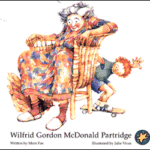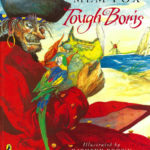Use literary critique to differentiate for gifted and advanced students.
Author’s Techniques- Using character, plot and language to influence the reader
Evaluate Author’s Techniques
Download PDF Literary Criticism Griffith 2011
5th Grade: For this lesson, we used 1/2 multi-flow map to evaluate the author’s use of character, appeal, logic and credibility of plot and setting, and the use of figurative language to influence the readers.
I used, Wilfrid Gordon McDonald Partridge, by Mem Fox to model my thinking and use of the map.
Visit Mem Fox’s Website http://memfox.com/books/
Author’s Techniques- Using unexpected details to draw the reader in…
 Our brains are natural pattern seekers, so when we notice something unexpected or unusual, we are automatically drawn toward it. This is true whether it is something as unexpected as an unexpected road on your way to work, to an unexpected detail in an image, story, or event, an unexpected comment or facial expression… You name it! In fact, this is a strategy often used by authors, advertisers, emergency management agencies, and many others to get people’s attention.
Our brains are natural pattern seekers, so when we notice something unexpected or unusual, we are automatically drawn toward it. This is true whether it is something as unexpected as an unexpected road on your way to work, to an unexpected detail in an image, story, or event, an unexpected comment or facial expression… You name it! In fact, this is a strategy often used by authors, advertisers, emergency management agencies, and many others to get people’s attention.
This point is easy to make with students and the opportunities are abundant. Be creative and have fun, for whatever draws you in, is likely to do the same for your students.
I used Mem Fox’s, Tough Boris to teach students about how authors use unexpected details to draw the readers attention. First I explained the objective- students would be thinking like authors and define details and patterns that grab a reader’s interest and attention.
With this in mind, we took a closer look at Boris. Students created a Bubble Map and color-coded the details or his personality and physical traits. See below. We then discussed elements in a story surrounding a character that might be unexpected. We looked at Physical and personality traits, and also a characters actions, thoughts, and words. Students pulled the information from their Bubble Maps and added them to the table. This process really allows the students to see the reader-writer connection.
With this in mind, we took a closer look at Boris. Students created a Bubble Map and color-coded the details or his personality and physical traits. See below. We then discussed elements in a story surrounding a character that might be unexpected. We looked at Physical and personality traits, and also a characters actions, thoughts, and words. Students pulled the information from their Bubble Maps and added them to the table. This process really allows the students to see the reader-writer connection.







